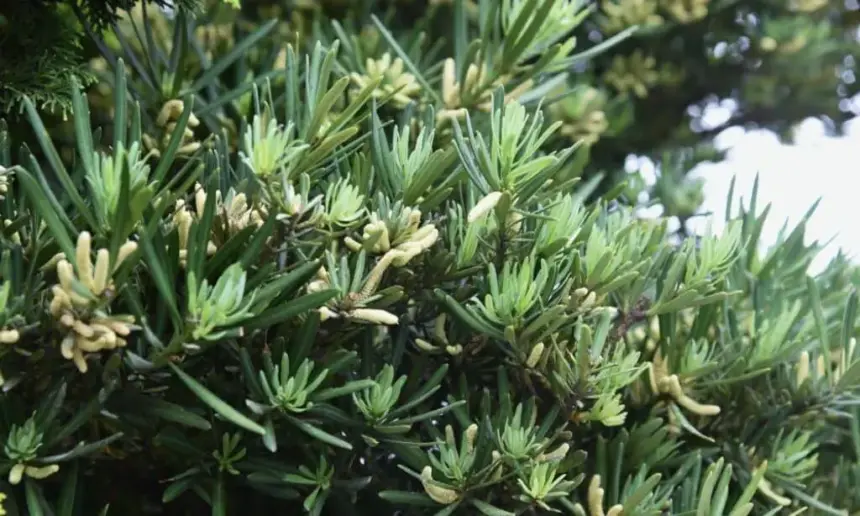Podocarpus Turning Yellow? (6 Reasons+Solutions)
Podocarpus can often be seen around private gardens as well as decorating streets, parks, or suburban areas.
It’s a coniferous tree that is frequently used in landscaping due to its evergreen leaves and beautiful branches.
Even though it doesn’t have needles like some other coniferous plants, its leaves are very long and flat and almost look like needles.
The leaves are commonly very densely arranged around branches providing not just a pretty sight, but also some privacy to the area behind them.
However, some homeowners growing Podocarpus may notice that these distinctive leaves occasionally may lose their green color and turn yellow.
While this messes with the plant’s visual appeal, more important is the fact that this happens because of certain underlying issues and can ruin the Podocarpus if not dealt with on time.
However, before you panic and assume the worst, it’s important to understand that there are several potential reasons why your Podocarpus leaves might be turning yellow.
Below, I’ll explain why is Podocarpus turning yellow and what to do about it.
Table of Contents
Reasons Why Your Podocarpus Is Turning Yellow

There are several reasons for Podocarpus turning yellow and they mostly have to do with the plant’s environment
This means that with slight adjustments to the conditions Podocarpus is growing in, you can in most cases, deal with these issues and have your plant revived and thriving again.
However, to be able to do so, it’s necessary to learn about these causes and monitor the plant so you can spot the symptoms on time and react.
Overwatering
Improper watering is the most common cause of making the Podocarpus leaves turn yellow, and this includes both overwatering and underwatering.
When you overwater the Podocarpus, the excessive water in the soil will block the oxygen and cause the accumulation of moisture.
Podocarpus grows best in well-drained soil and too much water may cause the rotting of the Podocarpus root system> one of the major symptoms of root rot is the discoloration of the leaves and their change to yellow.
To make sure you don’t overwater the Podocarpus, always check the soil before watering.
Simply stick your finger about one or two inches deep, and if the soil still feels damp, there’s no need to add water yet.
Only when the soil is dry give your Podocarpus a deep watering. Make sure that the soil drains well, so the roots are not left sitting in the water.
Underwatering
[amazon box=”B07BR52P26″]
Just like excessive watering, prolonged exposure to drought and lack of water also harm the Podocarpus and hinder its healthy growth.
In case the Podocarpus is not getting enough water, its leaves will shrivel and turn yellow.
This will start at the top portion of the foliage and eventually spread across the entire plant.
The lack of water will not only affect the leaves but may also dry out the roots, making it difficult for the Podocarpus to absorb the necessary nutrients from the soil.
If you notice that the Podocarpus is suffering from the lack of water, start watering it more frequently,
Whenever the soil feels completely dry to the touch you should thoroughly water the plant, while still making sure that the soil drains the water well, so you don’t cause the overwatering issues described above.
Check the soil every couple of days and act accordingly.
Lack of Sunlight
When growing Podocarpus, it’s important to find the right balance in terms of the amount of sunlight the plan will receive.
Podocarpus won’t respond very well to being exposed to direct sunlight for longer periods and may suffer because of it.
However, at the same time, it doesn’t grow well in full shade and needs at least 6 hours of sun per day to remain healthy.
When the Podocarpus isn’t receiving enough light, it won’t be able to properly perform photosynthesis because it won’t produce enough chlorophyll.
Because of this, its leaves will likely start to turn yellow in the absence of sunlight and will, after a while, begin to fall off.
Make sure that the location of the Podocarpus isn’t in too much shade and that there isn’t anything blocking its access to sunlight.
If necessary, prune the surrounding plants to make sure your Podocarpus can get the sunlight it needs.
Lack of Nutrients
[amazon box=”B000NJ1ZQQ”]
Another common issue that can result in Podocarpus leaves turning yellow is nutrient deficiency. The lack of nutrients can impact the pant differently depending on the type of nutrients.
If you notice that the leaves of your Podocarpus have changed their color to yellow, then the most likely reason is that they’re not getting enough nitrogen or iron.
Typically, the plant will lack a certain nutrient due to poor soil quality or the incorrect use of fertilizer.
So the first step in dealing with this issue is to check the soil and test it to see if it doesn’t have enough nitrogen or iron.
Nitrogen in the soil can be replenished by adding ammonium sulfate or nitrate. You can also use fertilizers developed specifically for Podocarpus.
They should provide all the nutrients your plant needs, but make sure to closely follow the instructions on how to apply the fertilizer.
Diseases
The discoloration of Podocarpus leaves and them turning yellow can also be a sign of fungal infection.
There are various factors that can cause fungal diseases, but the typical reasons include high humidity, overwatering, or the transmission of diseases from other infected plants or infected tools.
The most common fungal disease affecting Podocarpus is Phytophthora root rot, which attacks the root system and damages it, so the plant can’t properly absorb water and nutrients.
As a result, the Podocarpus foliage turns yellow, while the branches dry out.
To prevent this type of disease, make sure that you’re not overwatering Podocarpus and leaving roots to sit in water.
If the plant has already been infected, remove the affected branches and isolate the plant.
While the yellow leaves and dry branches can’t be revived, this may at least help you stop the spread of the infection.
Environmental Stress
Any sudden changes in the environment can also be the reason why the Podocarpus leaves are turning yellow.
These environmental stressors can come in different forms, but the most common are drought, extreme temperatures, dry winds, soil pollution, as well as stress the plant will feel when you transplant it.
The yellow leaves in these cases indicate that the Podocarpus is basically shutting down all of its non-essential functions in order to survive.
The only way to deal with these issues is to identify the problem and work to remove it.
So in the case of high temperature move the plant to a shady location, if there’s a drought, water it more frequently, and so on.
Conclusion
The discoloration of Podocarpus leaves when they turn yellow is commonly irreversible, meaning, there’s not much you can do to save them.
Therefore you should focus on preventing these problems in the first place and creating the optimal conditions for the healthy growth of your Podocarpus.
So, learning and understanding why this happens is the key to maintaining the plant in its optimal condition.
In case leaves still turn yellow, don’t panic, just react as soon as possible and take action to mitigate the effect of whatever issue is causing it.
With some luck and a timely reaction, the plant will soon come back to full health and restore its beautiful green foliage.




